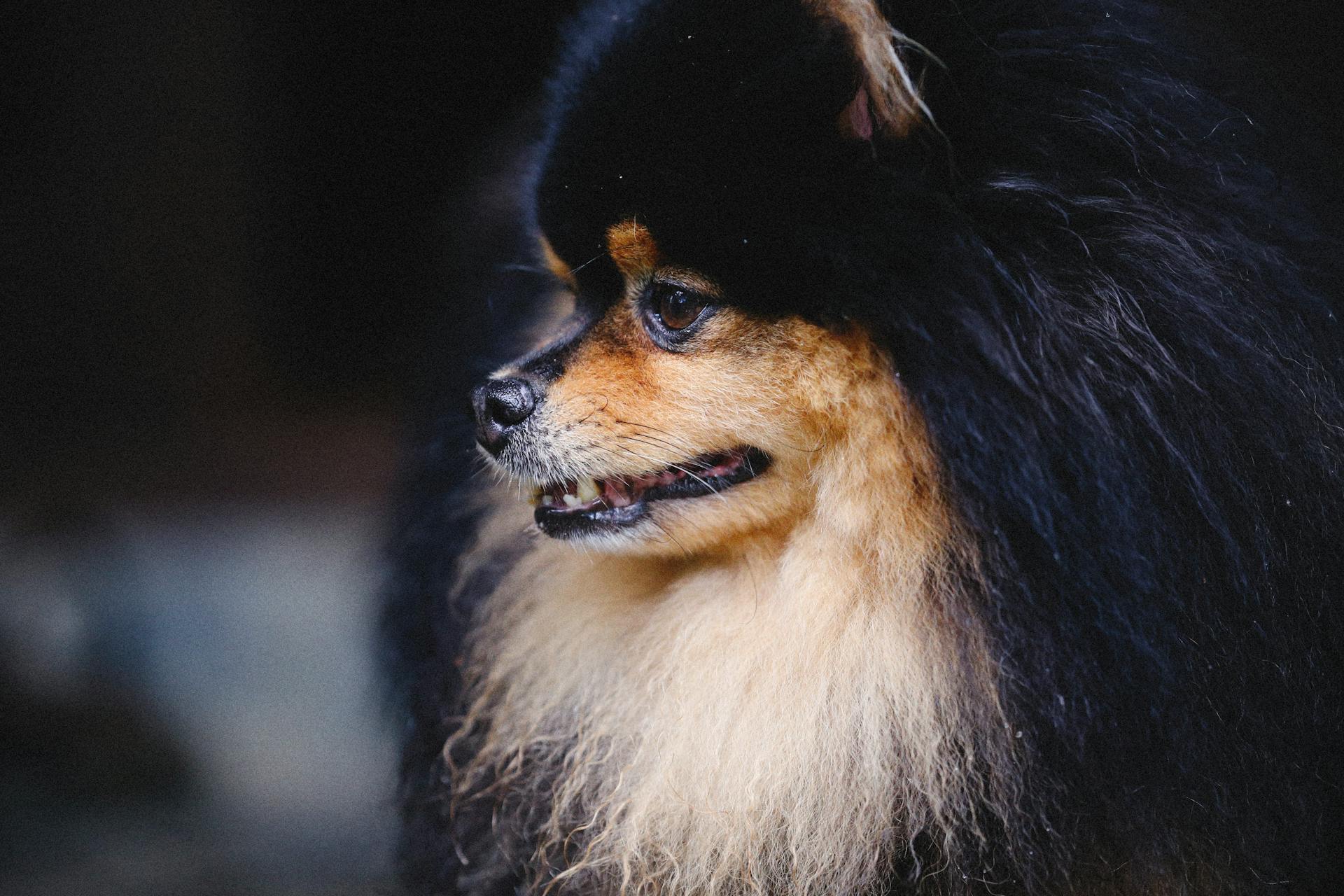
Pomeranian dogs are prone to eye problems due to their large eyes and delicate facial structure. This makes them more susceptible to issues like cherry eye and proptosis.
One of the most common eye problems in Pomeranians is cherry eye, which occurs when the gland in the third eyelid becomes inflamed. This can cause a red, painful bump to form in the corner of the eye.
Pomeranians are also at risk for proptosis, a condition where the eye bulges out of its socket. This can be caused by a blow to the head or a congenital defect.
Regular veterinary check-ups can help identify eye problems early on, reducing the risk of long-term damage.
Curious to learn more? Check out: Are Pomeranians Hypoallergenic Dogs
Causes
Pomeranian dog eye problems can be caused by a variety of factors, including genetic variants that lead to retinal degeneration, a condition that affects the retina at the back of the eye.
In Pomeranians, excessive tearing can occur due to irritation to the eyes or improper tear drainage, causing chronic tearing and stains under the eyes. This can be caused by dog eye infections, glaucoma, eyelash or eyelid problems, or corneal ulcers/scratch to the surface of the eye.
Some breeds, such as the Pomeranian, are more prone to excessive tearing due to shallow eye sockets or hair growth in skin folds around the eyes. White dogs, including Pomeranians, are also more likely to have visible tear staining on their faces due to the pigments in their tears.
A few possible causes of tear stains under a dog's eyes include:
- Shallow eye sockets, where tears can spill out onto the fur around the eyes
- Eyelids that are turned inward, blocking the drainage holes for tears (called puncta)
- Hair growth around the eye, wicking tears away from the eye and onto the face
- Blocked tear drainage holes (puncta), often caused by previous dog eye infections or eye damage
Clinical Signs
If you've noticed your Pomeranian acting differently, it may be due to eye problems. One of the first signs of vision loss in dogs is dilated pupils.
As your dog's vision worsens, they may become more hesitant to enter dark rooms or go outside at night.
Some Pomeranians may even bump into door frames or appear clumsy in new surroundings.
A common sign of vision loss in Pomeranians is abnormally reflective eyes when a light shines on them.
If your Pomeranian is experiencing cataract formation in both eyes, it's essential to consult with a veterinarian as soon as possible.
Here are some clinical signs to look out for:
- Dilated pupils
- Abnormally reflective eyes when a light shines on them
- Reluctance to enter a dark room or go outside at night
- Hesitance to go down stairs
- Bumping into door frames or clumsiness in new surroundings
- Cataract formation in both eyes
Diagnosis
Diagnosis is a crucial step in understanding and addressing Pomeranian eye problems. PRA is diagnosed with an eye exam focusing on the retina.
Both eyes are equally affected by PRA, making it essential to examine both eyes thoroughly. This can help identify any potential issues early on.
Your veterinarian may refer you to a veterinary eye specialist to confirm a diagnosis with additional testing, such as electroretinography (ERG). ERG can provide more detailed information about the retina's function.
It's essential to differentiate PRA from other forms of blindness in dogs, as other diseases may cause pain or additional systemic side effects. This can ensure you receive the most effective treatment for your Pomeranian's specific needs.
Treatment
Adding supplemental lighting inside and outside the house can help Pomeranians with vision decline, especially in the early stages. This can make a big difference in their daily lives.
Keeping furniture in the same arrangement and using safety gates to block access to stairs can also help prevent injuries. These simple precautions can make a big impact on your dog's safety and well-being.
You can also train your Pomeranian with verbal commands before their vision loss, which can help them navigate their environment more easily. This can be a fun and rewarding experience for both you and your dog.
Here are some steps you can take to help your Pomeranian feel safe and secure:
- Adding supplemental lighting
- Keeping furniture in the same arrangement
- Using safety gates
- Guiding them with a leash
- Training with verbal commands
Medication Application
Applying eye medication to your dog requires some care and attention to detail. It's essential to clean the area around your dog's eyes before applying any medication.
To clean the area, use warm water and a cotton ball. This will help remove any debris or dirt that might interfere with the medication. I've seen some owners use a damp cloth, but a cotton ball is generally gentler on the eyes.
If you're using eye drops, tilt your dog's head back and gently open the lid of the dropper. Place one hand on your dog's face to keep it steady and prevent the dropper from hitting their eyes. Squeeze the drops in the upper part of the eye. It's crucial to get the drops in the correct spot to ensure they're effective.
Explore further: Dog Flu in Bay Area
If you're using eye ointment, create a pocket by gently opening the lower eyelid. Again, place one hand on your dog's face to restrain their head. Squeeze the ointment into the pocket, making sure to get the right amount.
Here are some general tips to keep in mind:
- Always follow the instructions provided by your veterinarian.
- Use the correct amount of medication to avoid over- or under-medication.
- Be patient and gentle when applying the medication to avoid causing your dog stress or discomfort.
Treating the Problems
For minor eye issues, a saline eye wash can help rinse your dog's eyes, but it's essential to consult a veterinarian first. If your dog's eye problems are caused by tear stains, addressing the underlying issue, such as keeping hair near the eyes trimmed and treating infections, can help minimize skin irritation and coat discoloration.
To prevent further irritation, an Elizabethan collar can be used to prevent your dog from rubbing their eyes. If your dog's tear stains are caused by shallow eye sockets, there's no way to stop the discharge, but you can minimize skin irritation.
Dog eye infections can be caused by bacteria, viruses, or fungus, and require prompt veterinary attention. If you notice signs such as yellow, green, or red drainage from the eyes, swelling, crusting, and hair loss on the eyelids, or very red and swollen conjunctiva and whites of the eyes, take your dog to the vet immediately.
For your interest: How to Prevent Diabetes in Dogs

Your veterinarian may prescribe eye drops to heal the infection and relieve inflammation, as well as oral antibiotics if there's an infection of the eyelid.
For progressive retinal atrophy, management focuses on helping dogs avoid injury and feel safe in their environment as their vision declines. This can be achieved by adding supplemental lighting, keeping furniture in the same arrangement, using safety gates, guiding them with a leash, and training with verbal commands.
In some cases, gene therapy may be a prospective treatment for specific types of canine PRA, but it's not widely available. Your veterinarian can provide guidance on the best course of action for your dog's specific condition.
If your Pomeranian has watery eyes, it's essential to identify the cause, which is often a foreign substance entering the eye. You can try flushing out the offending fragment, but if it's been in the eye for a while, your dog may need more advanced treatment to prevent further damage.
Here's an interesting read: Hemorrhagic Gastroenteritis Home Treatment
Genetics
Genetics plays a significant role in Pomeranian eye problems, particularly Progressive Retinal Atrophy (PRA).
DNA testing is available for all known variants of PRA, but researchers have not yet discovered all the variants that cause the disease.
Dogs with two copies of the PRCD variant will almost always develop vision loss as an adult.
Some forms of PRA, like progressive rod-cone degeneration, are recessive, requiring two copies of the variant to consider a dog at-risk.
Dogs with PRA and those that test positive for known PRA variants should not be used for breeding without prior genetic testing and careful consideration of mate selection.
A few known variants of PRA are dominant, requiring only one copy, while others are X-linked, requiring one copy for males and two copies for females.
Some forms of PRA do not have any known genetic variants, meaning a dog could still develop the disease even if they test negative for the known variants.
For more insights, see: Dog Gut Health Test
Frequently Asked Questions
How to stop Pomeranian tear stains?
To prevent tear stains on your Pomeranian, keep the hair around their eyes trimmed short and clean the area daily with a damp cloth or contact lens cleaning solution. Regular grooming can help reduce tear stains and keep your pet's eyes clean and healthy.
Sources
- https://www.vet.cornell.edu/departments-centers-and-institutes/riney-canine-health-center/canine-health-information/progressive-retinal-atrophy
- https://pomeranian.org/watery-eyes/
- https://www.petmd.com/dog/general-health/evr_dg_eye_problems_in_dogs
- https://www.webmd.com/pets/dogs/dogs-and-tear-stains
- https://mountainvalleycountrystore.com/blog/77475/dog-eye-discharge-when-to-worry
Featured Images: pexels.com


